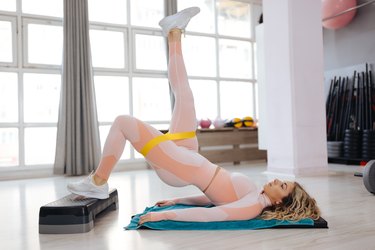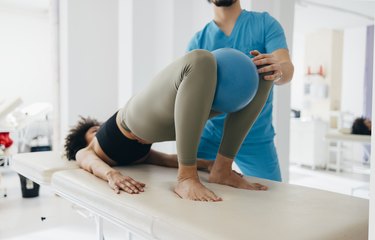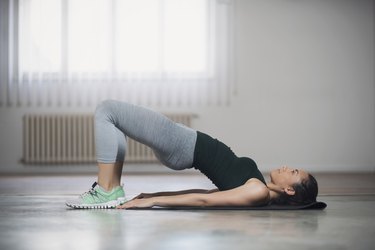
If you care about building a strong backside, you're probably well-acquainted with glute bridges. However, you may not be so familiar with their more advanced sibling: the single-leg glute bridge.
Let's fix that now. Here, we introduce you to the single-leg glute bridge, its benefits and common mistakes to avoid.
Video of the Day
- What is the single-leg glute bridge? It's a more challenging variation of the standard glute bridge exercise. You lie on the floor and raise your hips as high as possible with one foot off the ground.
- What muscles do single-leg glute bridges work? As you may have guessed, single-leg glute bridges primarily target your glutes — particularly the large gluteus maximus muscle. "They also work your hamstrings, your core, your calves and your quadriceps," Lauren Lobert Frison, DPT, CSCS, owner of APEX Physical Therapy, says.
- What's the difference between a single-leg glute bridge and a hip thrust? The difference between the two exercises lies in the set-up: The single-leg glute bridge is performed with your shoulders on the floor, while the hip thrust is done with your shoulders on a bench. Elevating your shoulders forces your hips to move through a greater range of motion, making the hip thrust more challenging than glute bridge variations.
- Are they better than regular glute bridges? Single-leg glute bridges aren't necessarily better than the standard version — they just offer different benefits. For example, the single-leg variation may be more effective for improving hip stability. "This is because the tensor fascia latae, a muscle involved in stabilizing the pelvis, works to keep you stable while you move one leg, helping improve strength and stability in this area," Rachel MacPherson, CPT, CSCS, a certified personal trainer with Garage Gym Reviews, an online fitness equipment and services reviewer, says.
How to Do the Single-Leg Glute Bridge With Perfect Form
- Lie on your back with your knees bent and feet hip-distance apart on the floor.
- Lift one leg off the ground, keeping your knee bent at a 90-degree angle.
- Push your planted foot into the floor and squeeze your glutes. Keep your opposite leg lifted and raise your hips as high as you can without arching your lower back.
- Pause briefly at the top of the movement. Then, lower your hips to the floor.
- Repeat. Do all reps on one side before switching.
5 Single-Leg Glute Bridge Benefits
1. Strengthens Your Glutes
The gluteus maximus is the main muscle targeted by single-leg glute bridges, because the movement centers on hip extension, or straightening the hips. And hip extension is the gluteus maximus' primary job, Lobert Frison says. This makes the single-leg glute bridge a stellar exercise for strengthening the glutes.
2. Makes Daily Activities Easier
The gluteus maximus is a big, powerful muscle that plays a key role in many everyday movements, from walking to climbing stairs to getting out of a chair. By strengthening your glutes, these activities will become easier, Lobert Frison says.
In addition to the glutes, single-leg glute bridges also strengthen the lower back and core, two areas that stabilize your pelvis. Greater pelvis strength and stability can help you maintain balance while walking, running and performing other single-leg movements. This is key for moving effectively, efficiently and pain-free, MacPherson says.
3. Eliminates Strength Imbalances
Most of us are stronger on one side of our body than the other. Often, the stronger side winds up doing more work during bilateral (two-sided) exercises like squats and everyday movements like walking. While this is normal, it can cause muscles on the stronger side to become overworked, eventually leading to pain or injury.
Unilateral (single-sided) exercises like single-leg glute bridges enable you to correct any strength imbalances, MacPherson says. Working one glute at a time forces your weaker side to carry its own weight, helping it catch up to the stronger side.
4. Prevents Knee and Lower Back Pain
Single-leg glute bridges strengthen the hip and glute muscles that help stabilize the pelvis. As the pelvis connects to the spine and legs, improving stability in that area also means better support for the muscles that control your knees and lower back. This can reduce strain on the knees and lower back during exercise and everyday life, ultimately preventing pain, per MacPherson.
Plus, people with weak glute muscles tend to rely too heavily on the lower back and leg muscles to make up for their glutes' shortcomings. "Over time, this creates overuse and stress on the knees and back and can lead to pain," Kasia Gondek, PT, DPT, CSCS, a physical therapist with Fusion Wellness and Physical Therapy, says.
Strengthening your glutes takes some of the stress of your knees and lower back, which helps prevent pain.
5. Boosts Squat Strength
Exercises that strengthen your glutes, lower back and core offer carryover benefits for other gym movements. For the single-leg glute bridge, the squat is a significant benefactor.
"Squats are primarily a quad-dominant exercise when done correctly, but they do call on the glutes to help push you out of the hole, which is the bottom of the squat," MacPherson says.
They also require strength in the core and lower back to keep your spine from flexing (bending) under load. "Flexion under load can cause back injuries, including disc pain and bulges," MacPherson explains.
Single-leg glute bridges can improve your squat strength by shoring up weaknesses in the muscles that support heavy squats.
4 Common Mistakes and How to Fix Them
1. Allowing Your Knee to Collapse Inward
It can be tough to keep your knee aligned when relying on one leg to support your weight. If you're not careful, the knee of your working leg may collapse inward when you lift your hips off the floor.
"It's crucial to maintain proper knee alignment when lifting your hips, as this can place stress on the knee joint and lower glute activation," Joshua Colon, CPT, CSCS, a certified personal trainer with Blink Fitness, says.
Fix It
Pay attention to your knee position during the exercise. Ensure that your knee is in line with the toes of your planted foot, Colon says. Adding a resistance band around your thighs and focusing on keeping tension in the band can help make sure your knees aren't collapsing in.
2. Overarching Your Lower Back
Another common mistake is using your lower back instead of your glutes to lift the hips off the ground. Often, this causes your lower back to overarch at the top of the movement. "Overarching the lower back can put stress on the lower back, which shifts focus away from the glutes," Colon says.
Fix It
Instead of using your lower back to initiate the movement, begin by lifting your hips and tilting your pelvis forward slightly. Engaging your core muscles will also help you maintain a neutral spine, Colon says.
3. Using Momentum
It's fairly common for people to jerk their non-working legs upward to create momentum to help lift their hips off the ground. This takes the focus off your glutes, which defeats the purpose of doing single-leg glute bridges in the first place.
Fix It
Keep your non-working leg in a relaxed position, Colon suggests. Focus on contracting your glutes and using them to lift your hips.
4. Positioning Your Foot Too Close or Far From Your Hips
Nailing your foot positioning is key for activating the glutes. If you place your foot too close to your hips, you may shift the focus to your quadriceps. Meanwhile, setting your foot too far from your hips may recruit too much of the hamstring muscle. Either way, you'll decrease the work from your glutes, Lobert Frison says.
Fix It
Note where you feel the exercise. If your quads are burning, inch your foot further away from your hips. If your hamstrings light up, bring your foot closer to your hips.
2 Single-Leg Glute Bridge Variations
1. Two-Up, One-Down Glute Bridge
If you struggle with the single-leg glute bridge, Colon suggests modifying it with the two-up, one-down variation. You'll use two legs to bridge up, and then lift one foot to lower yourself to the floor. This approach enables you to start the exercise from a more stable position, while still challenging your muscles to lower your hips with one leg.
- Lie on your back with knees bent and feet hip-distance apart on the floor.
- Push your feet into the floor and squeeze your glutes to raise your hips toward the ceiling.
- Pause briefly at the top of the movement. Then, lift one leg off the ground and use the other leg to lower your hips to the floor.
- Repeat. Do all reps on one side before switching.
2. Single-Leg Hip Thrust
If single-leg glute bridges are a snap and you're ready to progress, try the single-leg hip thrust. Elevating your shoulders requires your hips to move through a greater range of motion, making this exercise more challenging than the glute bridge, Colon explains.
- Sit on the floor and rest your upper back on a sturdy bench or plyo box.
- Place your feet hip-distance apart on the floor, knees bent.
- Lift one leg off the ground and bend to create a 90-degree angle.
- Squeeze your glutes and push through your planted heel to raise your hips toward the ceiling.
- Pause briefly at the top of the movement. Then, lower your hips to the floor.
- Repeat. Do all reps on one side before switching.


